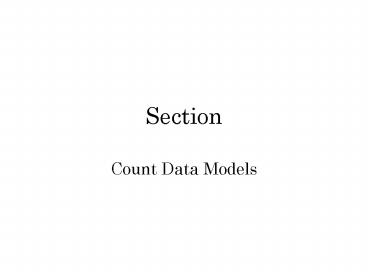Count Data Models - PowerPoint PPT Presentation
Title:
Count Data Models
Description:
If you cannot reject the null that d=0, report the Poisson estimates ... Ho: delta = 0 (Poisson model is correct) ... 1 delta = 6.21, Poisson is mis-specificed, ... – PowerPoint PPT presentation
Number of Views:84
Avg rating:3.0/5.0
Title: Count Data Models
1
Section
- Count Data Models
2
Introduction
- Many outcomes of interest are integer counts
- Doctor visits
- Low work days
- Cigarettes smoked per day
- Missed school days
- OLS models can easily handle some integer models
3
- Example
- SAT scores are essentially integer values
- Few at tails
- Distribution is fairly continuous
- OLS models well
- In contrast, suppose
- High fraction of zeros
- Small positive values
4
- OLS models will
- Predict negative values
- Do a poor job of predicting the mass of
observations at zero - Example
- Dr visits in past year, Medicare patients(65)
- 1987 National Medical Expenditure Survey
- Top code (for now) at 10
- 17 have no visits
5
- visits Freq. Percent
Cum. - -----------------------------------------------
- 0 915 17.18 17.18
- 1 601 11.28 28.46
- 2 533 10.01 38.46
- 3 503 9.44 47.91
- 4 450 8.45 56.35
- 5 391 7.34 63.69
- 6 319 5.99 69.68
- 7 258 4.84 74.53
- 8 216 4.05 78.58
- 9 192 3.60 82.19
- 10 949 17.81 100.00
- -----------------------------------------------
- Total 5,327 100.00
6
Poisson Model
- yi is drawn from a Poisson distribution
- Poisson parameter varies across observations
- f(yi?i) e-?i ?i yi/yi! For ?igt0
- Eyi Varyi ?i f(xi, ß)
7
- ?i must be positive at all times
- Therefore, we CANNOT let ?i xiß
- Let ?i exp(xiß)
- ln(?i) (xiß)
8
- d ln(?i)/dxi ß
- Remember that d ln(?i) d?i/?i
- Interpret ß as the percentage change in mean
outcomes for a change in x
9
Problems with Poisson
- Variance grows with the mean
- Eyi Varyi ?i f(xi, ß)
- Most data sets have over dispersion, where the
variance grows faster than the mean - In dr. visits sample, ? 5.6, s6.7
- Impose MeanVar, severe restriction and you tend
to reduce standard errors
10
Negative Binomial Model
- Where ?i exp(xiß) and d 0
- Eyi d?i dexp(xiß)
- Varyi d (1d) ?i
- Varyi/ Eyi (1d)
11
- d must always be 0
- In this case, the variance grows faster than the
mean - If d0, the model collapses into the Poisson
- Always estimate negative binomial
- If you cannot reject the null that d0, report
the Poisson estimates
12
- Notice that ln(Eyi) ln(d) ln(?i), so
- d ln(Eyi) /dxi ß
- Parameters have the same interpretation as in the
Poisson model
13
In STATA
- POISSON estimates a MLE model for poisson
- Syntax
- POISSON y independent variables
- NBREG estimates MLE negative binomial
- Syntax
- NBREG y independent variables
14
Interpret results for Poisson
- Those with CHRONIC condition have 50 more mean
MD visits - Those in EXCELent health have 78 fewer MD visits
- BLACKS have 33 fewer visits than whites
- Income elasticity is 0.021, 10 increase in
income generates a 2.1 increase in visits
15
Negative Binomial
- Interpret results the same was as Poisson
- Look at coefficient/standard error on delta
- Ho delta 0 (Poisson model is correct)
- In this case, delta 5.21 standard error is
0.15, easily reject null. - Var/Mean 1delta 6.21, Poisson is
mis-specificed, should see very small standard
errors in the wrong model
16
Selected Results, Count ModelsParameter
(Standard Error)































